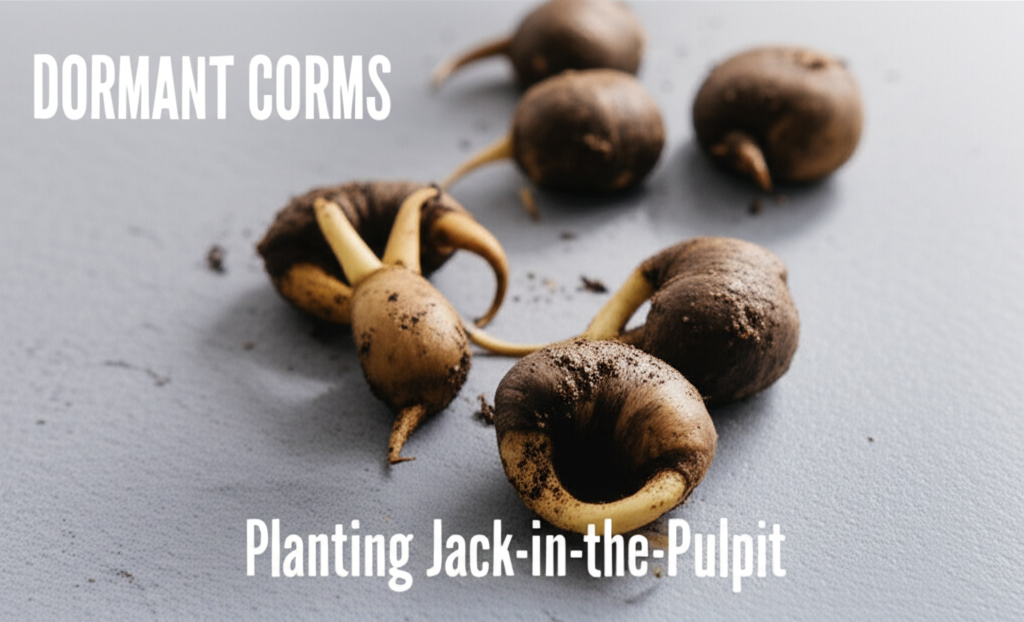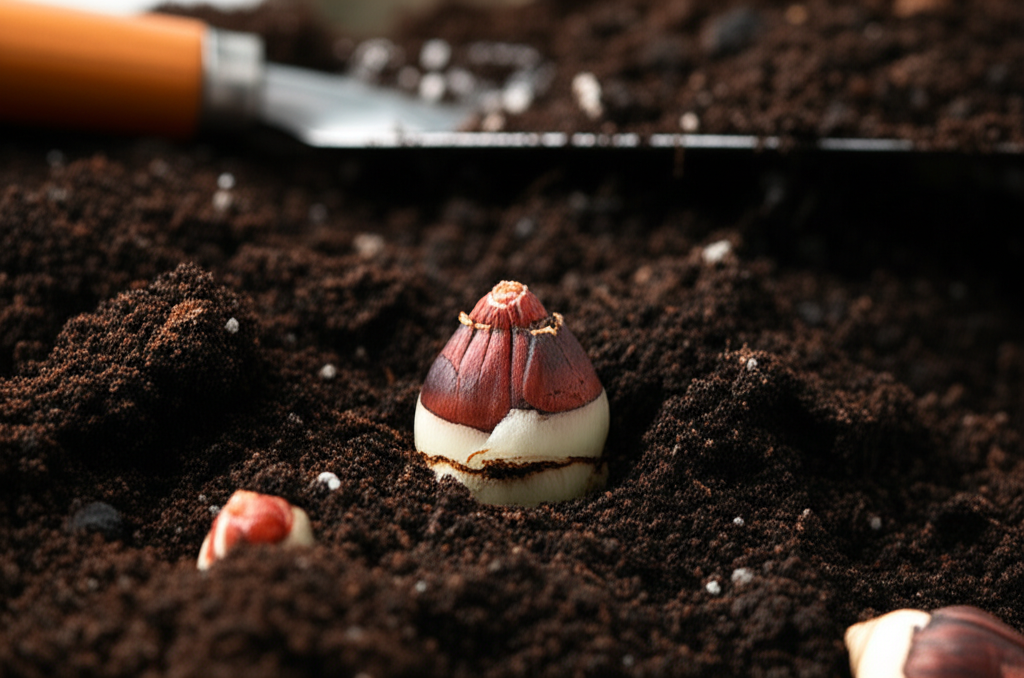The Allure of Jack-in-the-Pulpit: More Than Just a Curious Flower
Jack-in-the-pulpit, scientifically known as Arisaema triphyllum, is a native woodland perennial that captivates gardeners with its unique and intriguing inflorescence. Resembling a pulpit with a hooded “jack” peeking out, this plant is a true gem for shady, moist environments. While its aesthetic appeal is undeniable, its propagation from dormant corms offers a rewarding way for enthusiasts to expand their woodland gardens and share this botanical wonder. This guide delves into the intricacies of propagating Jack-in-the-pulpit from its underground storage organs, ensuring success for both novice and experienced horticulturists.
Understanding the Jack-in-the-Pulpit Corm: The Key to Propagation

At the heart of Jack-in-the-pulpit propagation lies the corm. Unlike bulbs or tubers, a corm is a swollen, underground plant stem that serves as a storage organ for food, enabling the plant to survive unfavorable conditions and regrow when conditions improve. The Jack-in-the-pulpit corm is typically flattened and disc-shaped, often with a papery outer covering. It is from these dormant corms that new plants will emerge.
The Corm’s Life Cycle and Dormancy
The corm plays a crucial role in the plant’s annual life cycle. During the growing season, the leaves and the distinctive spathe and spadix (the “jack” and “pulpit”) emerge from the corm. After flowering and producing attractive red berries in late summer or fall, the above-ground portions of the plant die back, leaving the corm dormant throughout winter. This dormant period is the ideal time for propagation, as the plant is not actively growing and is less susceptible to stress.
Factors Affecting Corm Development
The size and health of a corm are directly influenced by the growing conditions of the parent plant. Adequate moisture, dappled shade, and fertile, humus-rich soil are essential for robust corm development. Corms produced by healthy, well-established plants will be larger and more likely to produce vigorous new growth.
When to Propagate: Timing is Everything
The most opportune time to propagate Jack-in-the-pulpit from dormant corms is during the fall or early winter, after the foliage has completely died back. This ensures the plant has completed its growth cycle for the season and the corms are in their deepest dormancy. Waiting until the ground begins to freeze but is not yet solid makes lifting the corms easier.
Signs of Dormancy
Visually, dormancy is indicated by the complete yellowing and decay of the plant’s leaves and stem. There should be no signs of green growth remaining. The soil around the plant will also typically be cooler and moister than during the active growing season.
Post-Dormancy Considerations
While fall is ideal, propagation can also be performed in late winter or very early spring, just before the first signs of new growth appear. However, the later you wait into spring, the greater the risk of damaging developing shoots during the excavation process.
The Propagation Process: Step-by-Step
Propagating Jack-in-the-pulpit from dormant corms is a relatively straightforward process, requiring careful handling and attention to detail.
Step 1: Excavating the Corms
Begin by carefully identifying the location of the dormant corms. Use a garden fork or trowel to gently loosen the soil around the plant’s base. Work from a distance of several inches away from the expected corm location to avoid accidental damage. Lift the soil mass carefully, exposing the corms.
Step 2: Cleaning and Inspecting the Corms
Once unearthed, gently brush away as much soil as possible from the corms. Inspect each corm for signs of rot, disease, or damage. Healthy corms will be firm to the touch. Discard any corms that are soft, mushy, or show evidence of mold or pest infestation.
Step 3: Dividing the Corms (Optional but Recommended for Larger Corms)
Larger, well-established Jack-in-the-pulpit plants may produce offsets, which are smaller corms attached to the main corm. These can be carefully separated. If a corm is particularly large and appears to have multiple growth points, it can be gently divided using a sharp, clean knife. Ensure each section has at least one visible bud or growth point. Allow any cut surfaces to air dry for a few hours to form a protective callus before replanting.
Step 4: Storing Corms (If Not Replanting Immediately)
If you are not replanting the corms immediately, proper storage is crucial to maintain their viability. Store them in a cool, dry, and well-ventilated place. A good method is to pack them loosely in a container filled with peat moss, vermiculite, or wood shavings. Avoid storing them in plastic bags, as this can lead to moisture buildup and rot. The ideal storage temperature is between 40-50°F (4-10°C).
Step 5: Replanting the Corms
When you are ready to replant, choose a suitable location in your garden. Jack-in-the-pulpit thrives in shady to partially shaded areas with moist, well-drained, humus-rich soil. Dig a hole deep enough to accommodate the corm, typically 3-4 inches deep. Place the corm with the pointed or bud end facing upwards. If you divided the corm, ensure the cut surface is not in direct contact with soil. Space the corms about 6-12 inches apart, depending on the desired density of your planting.
Step 6: Watering and Mulching
After replanting, water the area thoroughly to settle the soil around the corms. Apply a layer of mulch, such as shredded leaves or compost, around the planting site. This will help retain moisture, suppress weeds, and protect the corms from extreme temperature fluctuations.
Key Facts and Comparison of Propagation Methods
While corm propagation is the most direct method for increasing Jack-in-the-pulpit numbers, understanding its characteristics in comparison to other propagation techniques provides valuable context.
| Propagation Method | Starting Material | Ease of Success | Time to Maturity | Pros | Cons |
|---|---|---|---|---|---|
| Corm Propagation | Dormant Corms | High | 1-3 years | Directly replicates parent plant, relatively quick to establish, can yield multiple new plants from larger corms. | Requires digging and handling of corms, potential for damage if not handled carefully, reliant on obtaining healthy parent corms. |
| Seed Propagation | Seeds from berries | Low | 3-7 years | Creates genetic diversity, allows for cultivation of new varieties, produces large quantities of plants from a single source. | Very slow to mature, germination can be erratic and difficult, seedlings may not resemble parent plants if cross-pollination occurred, requires stratification. |
| Division of Clumps | Established plants with multiple shoots | Medium | 1-2 years | Can be done with less disruption to existing plants compared to corm lifting, suitable for plants that form dense clumps. | Requires careful separation to avoid root damage, may stress the parent plant, not always feasible for younger or solitary plants. |
Troubleshooting and Tips for Success
Even with careful planning, occasional issues can arise during Jack-in-the-pulpit propagation. Here are some common problems and how to address them.
Corms Not Growing
- Cause: Corms may be too small, damaged, diseased, or planted too shallowly or deeply.
- Solution: Ensure corms are of adequate size and healthy. Adjust planting depth. Provide consistent moisture and appropriate light conditions. If using divided corms, ensure each division has a growth bud.
Rotting Corms
- Cause: Excessive moisture, poor drainage, or fungal infections.
- Solution: Replant in well-draining soil amended with compost. Ensure adequate air circulation. Avoid overwatering. If rot is extensive, the corm may be unsalvageable.
Slow Establishment
- Cause: Young or small corms may take longer to establish and bloom.
- Solution: Be patient. Provide optimal growing conditions. It may take a couple of seasons for smaller corms to reach flowering size.
Pest and Disease Prevention
While generally robust, Jack-in-the-pulpit can be susceptible to slugs and snails, which can damage new shoots. Monitor your plants and use appropriate organic pest control methods if necessary.
Pros and Cons of Jack-in-the-Pulpit Corm Propagation
Understanding the advantages and disadvantages of propagating from dormant corms helps in making informed decisions for your gardening efforts.
| Category | Advantages | Disadvantages |
|---|---|---|
| Speed & Reliability | Relatively fast to establish compared to seed propagation. High success rate when healthy corms are used. | Reliance on existing plants for corm material. |
| Genetic Integrity | New plants are genetically identical to the parent plant, preserving desirable traits. | Does not introduce new genetic variations. |
| Ease of Handling | Corms are relatively sturdy and easy to handle and replant. | Requires careful excavation to avoid damage. |
| Scalability | Larger corms can often be divided, increasing the number of plants exponentially. | The number of new plants is limited by the availability of mature parent plants. |
| Resource Input | Requires basic gardening tools and a suitable planting location. | Time investment for excavation, cleaning, and replanting. |
Cultivating a Thriving Jack-in-the-Pulpit Patch
Once your Jack-in-the-pulpit corms are successfully propagated and planted, providing them with the right environment will ensure their long-term health and vigorous growth.
Ideal Growing Conditions
- Light: Dappled shade or partial shade is ideal. Direct afternoon sun can scorch the leaves.
- Soil: Rich, moist, well-drained soil with plenty of organic matter is crucial. Amend clay soils with compost to improve drainage and aeration.
- Moisture: Consistent moisture is essential, especially during the growing season. They prefer consistently damp soil, mimicking their natural woodland habitat. Avoid waterlogged conditions, however.
- Mulching: A layer of mulch helps retain soil moisture, suppress weeds, and regulate soil temperature.
Long-Term Care
After propagation, your Jack-in-the-pulpit plants will require minimal care. Remove any dead foliage in late fall to prevent disease. Avoid disturbing the soil around the plants unnecessarily once they are established, as this can damage the developing corms. Fertilization is generally not required if the soil is rich in organic matter.
Conclusion: The Reward of Woodland Gardening
Propagating Jack-in-the-pulpit from dormant corms is a rewarding endeavor that allows gardeners to expand their collection of these fascinating woodland natives. By understanding the corm’s life cycle, timing the propagation correctly, and following these detailed steps, you can successfully cultivate a thriving patch of Jack-in-the-pulpit, adding a unique and enchanting element to your shade garden. The patience and care invested in this process will undoubtedly be rewarded with the distinctive beauty of this captivating plant for seasons to come.


